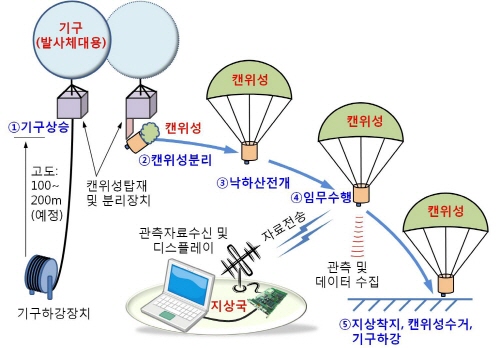event
Figure: The cansat is sent up into the air using a balloon and then separated at a certain height. The cansat slowly descends and sends terrestrial observation or atmospheric information back to earth.
KAIST will host the first ever Cansat Competition Korea, in which students from different age groups can participate in building and testing the performance of their custom satellites.
The Satellite Technology Research Center (SaTReC) at KAIST announced that it will take applications for the Cansat Competition Korea until May 25th. A cansat is a can-sized educational satellite that contains the basic elements of a real satellite. It is fired up to a few hundred meters in the air using balloons or small rockets and then separated like a real satellite, collecting data and sending the information back to earth. Cansat competitions are regularly held in the United States or Europe, where they have advanced space development programs, but this is the first time this competition will be held in Korea.
The competition caters to different age groups through a cansat experience science camp for elementary and middle school students and a cansat competition for high school and college students.
The science camp will be held from August 7th to 9th at KAIST and Sejong City and will include satellite education, visits to space development centers (KAIST Satellite Technology Research Center and the Korea Aerospace Research Institute), hand-on experience with basic cansat kits, and other various programs.
The science camp will consist of a maximum of 20 teams comprised of students from fifth to ninth grade. Each team will have an advisory teacher and 3 to 4 students and can apply for the competition at no cost.
The cansat competition will test high school and college students on their personally designed and built can satellites along with the creativity of their mission and developmental outcome.
The preliminary review will choose a maximum of 15 teams, while the secondary review will select the 5 teams that will make the final competition based on their design presentation. On August 9th, these 5 teams will be evaluated on their technical ability, mission capacity and presentation skills. The winning team will be given the KAIST presidential award along with a trophy and prize money.
Doctor Park from KAIST SaTReC explained that countries with advanced space technology actively support cansat competitions to expand the base of the field. He emphasized Korea’s need for regular cansat competitions to actively promote potential space researchers.
More information on the competition can be found on the homepage (http://cansat.kaist.ac.kr) or at the KAIST SaTReC (042-350-8613~4)

-
research KAIST’s Next-Generation Small Satellite-2 Completes a Two-Year Mission – the Successful Observation of Arctic and Forest Changes
KAIST (President Kwang-Hyung Lee) announced on the 25th of May that the Next-Generation Small Satellite-2 developed by the Satellite Technology Research Center (SaTReC, Director Jaeheung Han) and launched aboard the third Nuri rocket from the Naro Space Center at 18:24 on May 25, 2023, has successfully completed its two-year core mission of verifying homegrown Synthetic Aperture Radar (SAR) technology and conducting all-weather Earth observations. The SAR system onboard the satellite was design
2025-05-25 -
policy KAIST Elected to Universities Space Research Association Membership
KAIST joined the Universities Space Research Association (USRA) on May 4, and brought the Association to a total of 113 member universities. The expertise KAIST brings will broaden the Association’s collective strength in space-related science, technology, and engineering worldwide. Professor Hyosang Yoon from the Department of Aerospace Engineering will serve as the representative of KAIST to USRA. KAIST was selected by USRA’s current university members, in recognition of its si
2020-05-29 -
people KAIST Launches Woorisae II
Professor Sejin Kwon from the Department of Aerospace Engineering and his team succeeded in launching a science rocket, named ‘Woorisae II’ at Saemanguem reclamation. This rocket was developed in collaboration with the Satellite Technology Research Lab (SaRTec). The test-firing was conducted at 10:43 am on Sunday October 28, 2018 (35°N 42’ 06” 126°E 33’ 36”, Radius of 0.6NM). This launch was the follow-up to the previous launch that was c
2018-10-29 -
people KAIST to Publish Newsletter - 'KAISTAR'
KAIST to Publish Newsletter - ‘KAISTAR’ First edition on May 7To be issued every two weeks KAIST (President Nam Pyo Suh) will be publishing the first edition of a newsletter targeting high school students on May 7. The newsletter is named ‘KAISTAR’, combination of ‘KAIST’ and ‘STAR’, meaning any KAIST students can be a world-class star in scientific circles. The newsletter will be issued every two weeks, beginning May 7. KAISTAR is designed to
2007-05-08